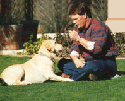 |
|||
|
|
 |
 |
|
|
 |
|||
|
Clicker Training: What it isn't There are three general opinions of clicker training: it's the hottest thing since sliced bread, a passing fad or an annoyance, on par with fleas at a breed show. Often, the latter two opinions are formed after hearing too much of the former. The rhetoric of some clicker trainers sounds like a cross between an infomercial and some kind of religious experience. Deciding which opinion fits your training style begins with knowing what clicker training is -- and what it isn't. Top 10 Misconceptions About Clicker Training 1) Clicker training is "all positive." -- No method of training is "all positive." By scientific definition, the removal of a desired reward is a "negative punishment." So, if you ever withhold a treat or use a time-out, by definition, you are a “negative” trainer who uses “punishment.” Invariably, people who say they are using "all motivational" or "all positive" methods are merely suggesting that they don't like using punishment -- so who does? It isn't that clicker trainers don't use aversive control, it's that the sequence is different and the presentation is done in a very precise, safe, limited fashion. In clicker training, aversive control is generally never used to create behaviors. Needed corrections are almost always applied at the end of the learning cycle, after the dog has a firm knowledge of the behavior. The actual “punishers” are determined by the dog and never anything that can cause damage, even if done incorrectly. The assumption that punishment isn’t a part of operant conditioning is historically, scientifically and logically silly. Operant conditioning merely means “learning by consequences” -- both pleasant and unpleasant consequences. If you tug back on your dog’s neck and he then stops trying to pull your arm off, you “punished” him for lunging. Pretending that it’s not punishment because it wasn’t horrible completely distorts the definition of the word -- and a common practice of people who claim to be “all positive.” i.e. They still use unpleasant consequences, they just call them “corrections.” The real issue is whether you know how to do it correctly. Why anyone would object to using a squirt gun to teach a 90 pound Chesapeake to not jump on Aunt Martha is beyond my comprehension -- but it is an example of using punishment. If you give the animal all the information they need to know what to do, you may be surprised at how rarely your dog needs corrections -- but there will always come a time when you need to tell your dog that obedience is not "optional." Those trainers who suggest that you can teach a dog with “all positive” training fail to acknowledge that their dogs possess instincts and personality that don’t always want a cookie. Try to lure a Jack Russell away from a cat, using a food treat you’ll know exactly what I mean. 2) Clicker training was invented by dolphin trainers. -- No. The first people to take operant conditioning out of the laboratory were Keller and Marian Breland, two students of B.F. Skinner, way back in the 1940's -- with dogs. It wasn't until the mid-1950's that Keller Breland invented marine mammal training. Yes, both types of training have similar roots, but "dogs ain't dolphins." For instance, marine mammals can be reinforced at any time during training AND performance -- like an obedience competition that allows you to use food in the ring. It is rare for dolphins and whales do more than four or five behaviors without some actual food treat -- and common for dogs to work for long periods in the absence of food. There are enough fundamental differences in the expectations of these two areas of training that attempting to transpose marine mammal methods directly to dogs may fail to utilize the dog's full potential -- or just simply fail. In my humble opinion, the track record of dog trainers stands as the longest-running, most widely adapted and ultimately most difficult form of training in the history of the world. To spell it out, that’s 15,000 years and hundreds of millions of dogs doing hundreds of different jobs, dependably, without teams of trainers for each animal and without constant reinforcement. Beat that, Flipper. 3) You can teach an animal to do anything with a clicker -- Nope, there are limits. Dogs have instinctive behaviors that are not fully controllable by any form of conditioning. (And gosh, I have seen my share those dogs over the years. ) Some instinctive behaviors can be controlled only partially. Some behaviors can’t be touched with positive reinforcement - see paragraph 1, above. The idea that clicker training can accomplish anything, is usually the wishful thinking of someone with limited experience. Hoping that clicker training can do everything misses the importance of the method -- there are some pretty remarkable things that only occur when using a clicker, or its equivalent about that, in a future column. 4) Clicker trainers use food, food and more food, as their means of reinforcing behavior. Nope. Food is a great tool for many situations, but has some obvious limitations. A smart trainer uses tone of voice, high pitched praise, affection, balls, squeakers or anything else their dog enjoys working for. The tendency to rely on food exclusively ignores the fact that no single reinforcer can keep a dog motivated at all times. 5) You can't teach classes with clickers because all those clickers will confuse the dogs. -- I taught the first clicker training class for dogs in 1987 - I guess I just didn’t know any better. This is another example of people who have never done something assuming it can’t be done. The reality is tyhat dogs have better hearing that we do and they quickly learn to listen for their owner's click, while ignoring all others. It helps that they have two ears and their brains are very good at locating the origin of sounds - including clicks. One side effect of this forced discrimination is that within a couple sessions, clicker trained dogs tend to be very focused on their trainers -- because they have to be. If you are still concerned about clickers confusing dogs in classes, my best advice is to cop the Nike slogan, "Just do it." 6) A clicker is a bad training tool, because you can't take it into the ring. -- It is important to realize that the clicker is a construction tool, rather than a performance tool. From that perspective, it is in the same class as a leash correction in competition -- both tools can shape behaviors, but they aren't part of performance. Going into the ring with a clicker is like walking out of the bathroom at a gala event with toilet paper stuck to your shoe. If you think you need the clicker in the ring, it is probably too soon for you to be in the ring. 7) A word, ("good" "yes" "ready") works just as well as the clicker. -- No. There are still some people who seem to have an allergy to clickers, even though they know how well they work. Having used both clickers and words, several thousand times, I can assure you that the difference between a clicker and a word is easily observable. The essence of this method is using a precisely timed signal to mark good behavior. Words are far less efficient as "behavior markers" than a crisp, quick sound, like a metallic click. This does not mean that clicker trainers always use a clicker in every training situation. Next month we will look at the way the clicker works, and why it is not always the best,or only tool for the job. 8) Using a clicker to modify an instinctive behavior, like herding, hunting or bite work, will wreck the animal's drive. Nope. All trainers use instinctive behaviors as the foundation for their training. Herding and Schuttzhund trainers modify instinctive behaviors, all the time -- they just call it something else, like "building drive". Regardless of what you call it, as long as you are clear on how to use a clicker to give information to the dog, the motivation (prey drive, etc.) will still work to motivate the dog to give good performance. The clicker is actually a great tool for fine tuning a high drive dog who is barely under control. 9) Clicker trained dogs are unreliable and "throw" behaviors at you, so you never know when they will offer the wrong behavior, just to get a treat. It is true that clicker trained dogs are more variable in the learning stages of a behavior than traditionally trained dogs -- that's one of the great strengths of the method. However, using corrections and reinforcements to maintain a learned behavior are no different with a clicker dog than with a traditionally trained dog. i.e. If your dog starts throwing behaviors at you during a performance, just say, "NO". He will soon get the idea that creativity is for training and precision is for performance. As for reliability, there are several clicker-trained, FEMA certified, Search and Rescue dogs -- and several hundred clicker trained, working service dogs. Reliability is not really dependent on whether you use a clicker or food in training. As with all methods of training, much of the reliability is a matter of how well the trainer crafts the training to match the dog's temperament. Note: See my comment about “all postive” training, above. Reliability also depends on teaching a dog that obedience is required - or else there will be an unpleasant consequence. The fact that you taught a behavior with positive reinforcement and then added the element of “you have to do this” isn’t something to argue about - it’s simply one of many sequences and blends that can produce greatness or garbage, depending on the dog and the trainer’s skill. 10) Clicker trainers just sit around waiting for the dog to offer a behavior. -- Not by a long shot. Clicker training places great emphasis on discovering efficient ways to "get the behavior to happen." Clicker training brought target sticks to obedience training, in order to cut down on waiting for the animal to "accidentally" do a perfect "go-out." Waiting around for a behavior to happen is not my idea of efficient training. After more than 25 years and 7,500 dogs (and 8 other species) worth of clicker training I have come to respect the clicker's power for shaping good behavior - and I have also learned its limitations. My goal is to offer you tools that can help you take an objective view of this new tool and some ideas on how to utilize its power. With a little effort, you may just find out what all the fuss is about.
|
|||
|
Copyright 1994-2013 Gary Wilkes. All rights reserved.
|
|||

